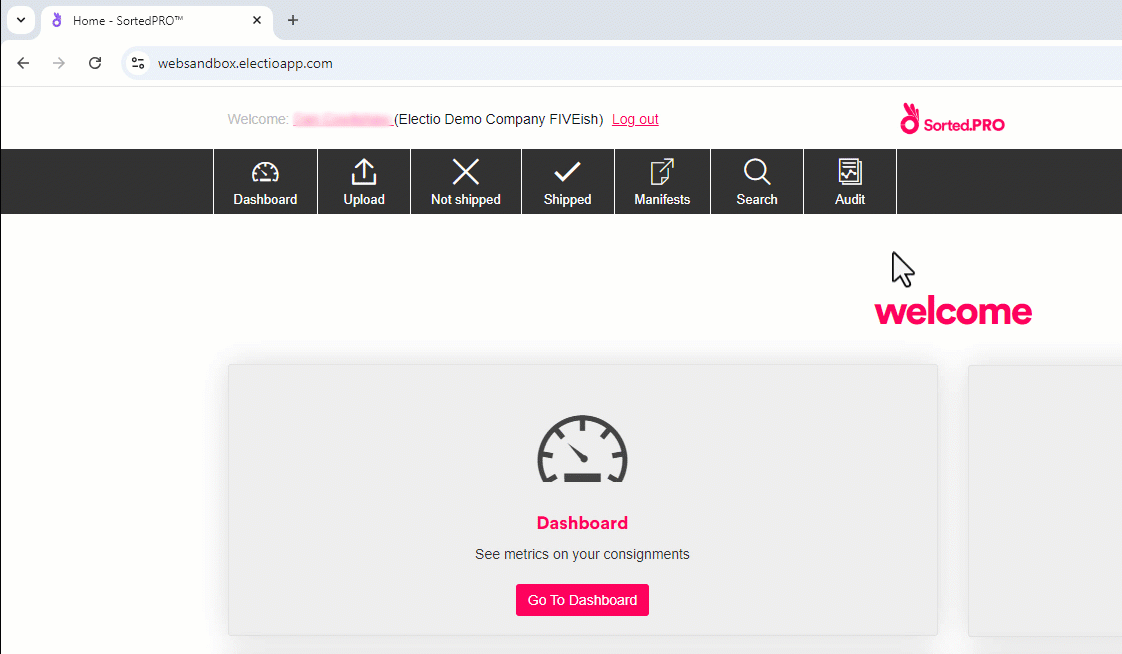Get Started with PRO Consignments APIs
Welcome to SortedPRO! Here you'll find a brief overview of PRO's Consignments APIs and how you can use them.
Consignments Overview
In PRO, a consignment is a collection of one or more packages that are shipped from the same origin address, to the same destination address, on behalf of the same Sorted customer, using the same carrier service, on the same day. Consignments form the basis of PRO's Consignments API suite, which enables you to build flexible shipping workflows that manage a consignment's journey from customer order right through to delivery.
PRO's Consignments suite offers the following APIs:
- Allocation - Allocates consignments to an appropriate carrier service.
- Carrier Services - Returns available carrier services.
- Carriers - Returns available carriers.
- Consignments - Adds, gets, updates and deletes consignment information.
- Customs Docs - Returns customs docs for international consignments.
- Delivery Options - Returns potential delivery timeslots for consignments. Access to PRO's delivery option endpoints requires a SortedHERO license. This component is sold separately to our main SortedPRO product.
- Events - Searches for specified consignment events.
- Labels - Returns labels for a consignment.
- Manifest - Adds consignments to the relevant carrier manifest.
- Orders - Adds, gets, updates and deletes order information.
- Package Sizes - Returns standardised package sizes.
- Packages - Deletes a package from a consignment.
- Pickup Options - Returns potential pickup locations and timeslots for a consignment. Access to PRO's pickup option endpoints requires a SortedHERO license. This component is sold separately to the main SortedPRO product.
- Quotes - Returns manual delivery quotes for a consignment.
- Shipping Locations - Returns pre-configured shipping locations.
- Tracking - Returns tracking information for a consignment.
Note
- For example API call flows, see the PRO Call Flows section.
- For API reference information, see the API Reference.
Authentication
You will need to provide a valid API key in every call you make to SortedPRO. When a new user account is created, PRO generates a unique API key and allocates it to the new user. To view your API key:
- Log in to the PRO dashboard and select Settings > Users & Roles > User Accounts to display the User Accounts page. A list of the user accounts that you have access to is displayed.
- Click the Edit User button for your account to display your account details.
- Click Show API Key. PRO prompts you to re-enter your UI password.
- Enter your password and click Retrieve API Key to display your API key.
To use your API key, include it in an ocp-apim-subscription-key header when making calls to PRO. If you make an API call to PRO without including an API key, then PRO returns an error with a status code of 401 (Unauthorized).
Example API key:
ocp-apim-subscription-key: NzI1M2U0MjEtOTExNy00MWI1LWFlM2MtYTYxYTMwZmQ3NWM5
Specifying Request / Response Format
PRO's APIs support both JSON and XML content types. You should state which content type you are sending for each API request sent to PRO. To do so, pass a content-type header with a value of application/json, text/xml or application/xml (as applicable) in your request. All other content types are invalid.
You can also specify the content type that you want PRO to use in API responses. To do so, pass an accept header with a value of application/json, text/xml, or application/xml in your request. If you don't pass an accept header then PRO responds with application/json.
content-type: application/json
accept: application/json
Specifying API Version
You should include an electio-api-version header specifying the API version to use in all PRO API calls. The current version is 1.1.
electio-api-version: 1.1
Using the Sandbox Environment
All of the URLs and examples given in this documentation relate to PRO's live production environment. However, we also offers a sandbox environment which provides a safe development area in which you can integrate with PRO without running the risk of inadvertently transmitting data to carriers. The sandbox works in the same way as the production (live) environment, but is self-contained and uses a separate dataset, authentication and password.
To call APIs in the sandbox environment, you will first need to set up a sandbox API key. To do so, log in to the sandbox environment user interface and follow the process listed in the Authentication section of this page.
To call an API in the sandbox rather than the production environment, substitute the api.electioapp.com portion of the API's base URL with apisandbox.electioapp.com.
Tip
Don't forget to use your sandbox API key (as opposed to your production API key) in the ocp-apim-subscription-key header when making the call.
For example, to call the Create Consignments endpoint in the production environment, you would send a POST request to https://api.electioapp.com/consignments. To call the same endpoint in the sandbox, you would send a POST request to https://apisandbox.electioapp.com/consignments.
Using a password manager
A password manager is a software or internet browser tool (e.g. 1Password, NordPass, Safari and Google password manager) designed to help users securely store, manage, and generate passwords for various online accounts. It works by linking your login credentials with a corresponding URL.
When you log out of our Sandbox and Production (live) user interfaces, the URL changes from the initial URL which may be linked to your login credentials. This can prevent you from logging back in as the password manager using your stored password will attempt to log in using it's saved URL linked to your credentials.

To resolve this, you may need to manually type your login information rather than relying on the password manager autofill data or you can include your login credentials for the additional URL that you are directed to following a log out action.